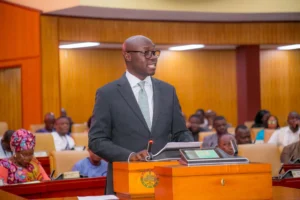
Dr. Kwakye
The Institute of Economic Affairs (IEA) has said the 2020 Budget and Economic Policy is not ambitious enough to stimulate stabilization and growth.
Making a presentation today to state IEA’s position on the 2020 Budget, Director of Research at the institute, Dr. John Kwakye said the budget does not involve policies that would bring about fundamental changes that will help the country make the needed quantum development leaps over the medium term.
“The targets in the budget are not sufficient, they are not ambitious. We see the budget as involving some tinkling and tweaking of figures to stay within a certain boundary defined by the fiscal responsibility act but that will only ensure small incremental developmental accounts for the country over the medium term.”
“The budget is not ambitious enough to bring about fundamental changes that will allow Ghana to make the needed quantum development needs. The figures and policies are also defined by political sensitivities. We think the budget is sensitive to political considerations.”
While Dr. Kwakye believes the 2020 budget is not ambitious enough to stimulate growth, Research Fellow with the Institute for Fiscal Studies, Dr. Adu Owusu Sarkodie thinks otherwise.
Dr. Sarkodie had described as overly ambitious the government’s revenue targets for 2020.
The Finance Minister in the budget statement said the government is aiming at increasing the tax-to-GDP ratio from 13 percent to 20 percent in 2020.
This was against the backdrop that the GHS5 billion shortfall in government’s revenue target for July 2019.
Although the government has missed its revenue targets over the years, it is still hopeful that it can generate GHc67.1 billion in revenue in 2020.
The Finance Minister described this target as part of “radical policy and institutional reforms” towards raising the tax-to-GDP ratio over the medium term.
The government said there would be a focus on efficiency and base-broadening rather than imposing new taxes on people and businesses.
This is with a view to raising the domestic revenue towards achieving the Ghana Beyond Aid vision, the government explained.
But Dr. Adu Sarkodie said though the move is aimed at consolidating the gains made so far, the government may be promising more than it can deliver.
“I mean how can you project to grow your tax revenue as a ratio of GDP from 13 percent to 20 percent in one year. That is a very over-ambitious statement to make because 20 percent is not something small you can achieve within a year.”
Currently, Ghana’s tax-to-GDP ratio of 12.9 percent in 2018 is below the average of middle-income countries.
Dr. Adu Sarkodie also observed that the reviews and upward adjustments to some taxes and levies announced will not have any significant strain on citizens.
“These are marginal. They are not too significant that they can cause a huge upsurge in inflation rate and disturbances in the Ghanaian economy. These are little things that we can accommodate.”
Among other revenue measures, the government renewed and extended the National Fiscal Stabilisation Levy and Special Import Levies (SIL) for five years to support the Budget.
Ofori-Atta seeks Parliament’s approval to spend GH¢86 billion in 2020
Government is seeking to spend nearly GH¢86 billion on various planned programmes and initiatives in 2020.
The amount being sought by the government represents more than 21 percent of what the government is likely to spend for this year.
According to the 2020 budget statement, nearly 25 percent of the planned expenditure will go into the payment of interest on the government’s debt. Apart from the interest payments, the projected amount of money to be spent on wages and Salaries is close to GH¢23 billion.
Although the government is hoping to spend more than 50 percent of what it spent on the provision of infrastructure in 2018, that amount is only GH¢9.3 billion – a little below 11 percent of the overall GH¢86 billion total expenditure.
The allocation made for goods and services is GH¢8.3 billion, which represents 9.7 percent of the projected total expenditure (including arrears clearance).






